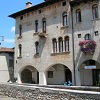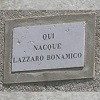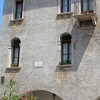 Lazzaro Bonamico
Lazzaro Bonamico  Lazzaro Bonamico
Lazzaro Bonamico Life
Lazzaro (or Lazaro) was a great Venetian humanist of fifteenth
century. He was born between 1477 and 1479 from Amico (son of
Sebastiano) and Dorotea, in Bassano del Grappa (Vicenza, Italy).
Lazzaro's native home (photo 1,
2 and 3)
lies in the uptown, in the square that bears his name.
He began his cultural training in Bassano, then moved to Padua,
where he was a pupil of Pietro Pomponazzi
and Niccolò Leoniceno. In 1510,
in Mantova, assumed the appointment of tutor of Francesco Cantelmo
and then of Galeazzo Gonzaga. In 1519 he went back to Padua and
in 1521 moved to Rome, where he was in contact with Angelo Colocci,
and in 1527 was in Venice and then in Padua. In 1530 he moved
definitively to Padua, where he was appointed as a professor of
Greek and Latin at the local University.
From a letter written by Lazzaro's Hungarian friend Sigmund Gelous
Torda to František Révai we know that in 1549 he had
an accident: he tumbled down the stairs and broke his hip, so
he could not move his right leg, and he was cured "by physicians
and surgeons". In spite of this accident, which occurred
when he was an old man (about 70 years old), Lazzaro lived fot
three more years and died in Padua in 1552.
The humanist was also known as Lazzaro da Bassano and his surname
is also reported as Bonamici, Buonamico, Buonamici, Bonamigo,
Bassani or Basciano.




Works
Lazzaro was a
pupil of Pietro Pomponazzi and commented and continued the work
of his master, above all in the field of physics. Contrarily to
other fellow disciples, he openly supported the materialistic
ideas of the master, together with Giulio Cesare Scaligero, Simone
Porzio, Andrea Cesalpino, Sperone Speroni, and the professor Cremonino
da Cento who made carve on his tomstone: "Hic iacet Cremoninus
totus", meaning that, besides the body, buried in the
grave, there was nothing.
He was an authoritative exponent of the group of the Ciceronians,
aimed to spread a style inspired to the return to the Roman classicism,
taking as their models Cicero (for prose) and Virgil (for poetry),
even for works in vulgar tongue (the present Italian language).
Lazzaro was a friend of Pietro Bembo, the most authoritative of
the Ciceronians, even if with some reservation for its positions.
He was a member of Padua's Accademia
degli Infiammati, founded in 1540 by Leone Orsini with the
motto «Burnt the mortal, to heaven will ascend the eternal».Other
members were Pietro Aretino, Ruzante, Sperone Speroni, Benedetto
Varchi and Luigi Alamanni. There were held exercises also in Greek
and Latin. With Speroni, who took the chair of the Academy in
1542, the activity was carried out mostly in vulgar, on philosophical
and literary arguments. The Academy was dissolved between 1545
and 1550.
Between his pupils in Venice the future cardinal Agostino
Valier (or Valeri), (1531-1606) who later was the bishop of
Verona, and moreover was master of Bunel,
Dolet and Longueil.
He was an authoritative supporter of the superiority of the Latin
on the vulgar, and so he appears in the Dialogo
delle lingue (Dialogue of languages, 1542) by Sperone
Speroni, in which he imagines a debate between Lazzaro, Pietro
Bembo and two anonymous characters, on the occasion of the appointment
to Lazzaro of the chair of Greek and Latin eloquence.
Barthélemy Masson, sent on a mission in Italy by Francis
Ist of France, in Padua met and described with great praises,
besides Alessandro Socino, also Lazzaro Bonamico, with whom he
met by a common friend.
None of the works of Lazzaro was sent to the press while he was
still alive, and the circulation of his ideas was entrusted mainly
to manuscripts and university lessons, in which imposed the secret
to his own disciples. His most important work (Concetti della
lingua latina, Concepts of the Latin language) was printed
for the first time in 1562, even if this contrasts with what was
written in 1539 by the Venetian bookseller and humanist Nicolò
Franco, who quotes the works of Lazzaro between those that
could not lack in a serious bookshop. The humanist from Cremona
Benedetto Lampridio, wrote a 'metropindaric' ode to Lazzaro Bonamico.
a portrait
A bronze
bust of Lazzaro is exposed in the Museo Civico of Bassano
del Grappa; it was sculptured by Danese
Cattaneo (or Cataneo) (approx. 1509-1573), native of Colonnata
(near Carrara, Tuscany), a mannerist sculptor, pupil of Sansovino.
The work is considered a kind of prototype
for the typology of the portrait-busts.
bibliographic
references:
Francesco Piovan (1988)
- Per la biografia di Lazzaro Bonamico (Contributi alla storia
dell'Università di Padova)
http://www.italica.rai.it/rinascimento/parole_chiave/schede/bonamico_lazzaro.htm
http://www.ens-lsh.fr/labo/cerphi/biblio/pompon.htm
http://www.studiolum.com/es/silva2.htm
http://www.classicitaliani.it/desan/desan12.htm
http://www.italica.rai.it/rinascimento/parole_chiave/schede/accademia_infiammati.htm
http://www.wga.hu/frames-e.html?/bio/c/cattaneo/biograph.html
http://www.in-su-la.com/personali/franco.htm
http://www.cronologia.it/storia/aa1200o.htm
http://www.kwart.kataweb.it/kwart/ita/magazinedett.jsp?idContent=227695&idCategory=660
http://www.fiu.edu/~mirandas/bios1583.htm
http://www.italica.rai.it/rinascimento/cento_opere/speroni_dialogo.htm
http://www.centrodirittiumani.unipd.it/scuola0304/pilota/_ppe_vi/STORIA/PPE%20STORIA/DE%20MARTINI_UNIVERSITA'.doc.
 page
last updated:
February 9th 2008
page
last updated:
February 9th 2008